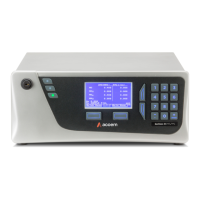the use of 1/8” glass-lined SS tubing or passivated/deactivated SS tubing for all gas cylinders
connections. Teflon, FEP or ideally MFA tubing is suitable for use with sample lines.
Ensure the external converter is mounted close to the instrument to reduce tubing lengths.
A new ammonia monitoring system will require a long time for all of the sample and calibration
lines to become properly conditioned. Ecotech recommends the first time a system is installed to
run NH
3
gas through the system for several hours to properly condition the lines.
Suitable NH
3
gas standards can be more difficult to source than a standard NO cylinder. The
moisture content of the cylinder can have a very large impact on the apparent concentration and
will adversely affect the converter efficiency. Gas standards should be as dry as possible to
ensure correct concentration is maintained.
NH
3
gas cylinders must be kept in a stable temperature environment to ensure the concentration
is stable. In colder temperatures, the NH
3
gas can stick to the walls of the gas cylinder and change
the apparent concentration.
Regulators used for the NH
3
cylinder should be dedicated to avoid contamination of other gas
systems.
Note: The power on/off switch is accessible from the rear of the instrument only. Install the
instrument so that the on/off power switch is accessible.
Figure 6 – Example Setup for S44 Monitoring System

